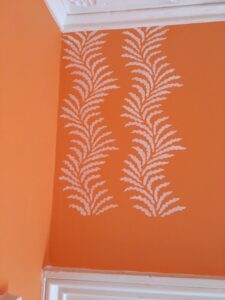06 Aug The Ancient Art Of Stencilling- A Project By Decorative Artist Richard Bagguley
Many of the techniques used in specialist finishes (Faux finishes) have been around for
hundreds, even thousands of years, for example, stenciling.
The Chinese were the first to develop a paper-based stencil around 105 AD and used the
invention to advance their printing techniques. Soon, stenciling made the transition to cloth and
colorful patterns were transferred onto garments, from there stencils were used as decoration in
the home, on furniture, and in works of art.

I first started using stencils for some of my earlier faux finish work in the late 1980s when it was
very much in vogue with even specialist books being written on the subject.
Last year one of Londons more interesting Interior designers approached me with a project
which involved covering all the passages of the hallway of his private residence with a repetitive
scrolling fern design.
There are some small technical as well as practical problems to be solved in covering large
areas in a perfectly executed repeating pattern using stencils without leaving any untidy edges.

This involved finding a company to machine cut my stenciled designs on a practically weighted
plastic which could be re-used and then measuring all the walls and slightly adjusting the gaps
between the design to fit neatly into each section of the wall taking into account the long drops
between floors.
All the walls in the hallway were prepared and painted the required color in this case a vibrant
slightly muted orangey-red, and we made some samples to make sure that the colors
co-ordinated and the paint was the right density as to not allow the edges to bleed.
It took a team of three decorative artists 4 days to complete over 100m2 of neatly executed
scrolling fern pattern using 5 sets of the plastic stencils.




No Comments